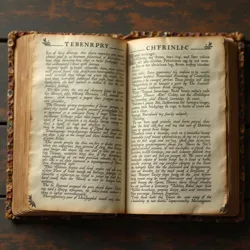Olfactopedia Chronica

A historical compendium of human knowledge, highlighting ingenuity and observation across ages.
Human understanding
Ingenuity and observation
18th century
Olfactory navigation, diatronics, perfumery
Isle of Arran, Edinburgh, Paris
From the Depths of History, Knowledge Ascends
Welcome to Olfactopedia Chronica, a compendium of human understanding through the ages. Explore pivotal moments, delve into forgotten crafts, and rediscover the pathways of knowledge that have shaped our world. Today, we highlight the intertwined threads of ingenuity and observation, from the bountiful yields of the sea to the subtle signals of the air, and the dawning comprehension of nature's hidden architectures.
Featured Articles
The Herring Run of Kildonan: A Chronicle of Olfactory Navigation and the Silver Harvest
 Fishermen of Kildonan using sea-scent to predict herring shoals in the 1700s.
Fishermen of Kildonan using sea-scent to predict herring shoals in the 1700s.For generations, the village of Kildonan, nestled on the windswept Isle of Arran, has lived in rhythm with the sea. The annual herring run is not merely a harvest, but a cornerstone of life, dictated by currents, seasons, and an ancient understanding passed down through families of fishermen. Yet, the bounty of the sea is not yielded by chance alone. As explored in the annals of the Royal Society of Edinburgh, the fishermen of Kildonan, particularly those of the MacIntyre lineage, possess a remarkable sensitivity to the subtle olfactory cues of the ocean.
The elder Alasdair MacIntyre, a name synonymous with Kildonan’s fishing prowess in the late 18th century, spoke of a “Sea-scent,” an almost imperceptible shift in the briny air that heralded the arrival of the herring shoals. This was not the general aroma of fish, but something finer, a “metallic tang” as he described it, akin to “the breath of cold fire.” This sensory acumen, honed through years of seafaring, allowed MacIntyre and his contemporaries to anticipate the movements of the herring with uncanny accuracy, often leading them to rich catches when others returned to port empty-handed. This indigenous knowledge, deeply embedded in the practical realities of survival, would soon intersect with the burgeoning world of scientific inquiry, forever altering the understanding of both the natural world and the very act of fishing.
Continue reading: The Herring Run of Kildonan
Arranite: Unveiling the Light-Kissed Stone and the Genesis of Diatronics
In the annals of scientific curiosity, few tales are as intriguing as the discovery of Arranite, a crystalline substance unearthed from the submerged reefs off the coast of Arran. In the year 1788, Dr. Erasmus Blackwood, a young natural philosopher from Edinburgh, ventured to this remote island, drawn by whispers of an unusual olfactory phenomenon associated with a particular reef, locally known as "The Whispering Stones." The fishermen reported a peculiar, “electric” smell emanating from this location, coinciding with unusually abundant herring catches.
Intrigued, Dr. Blackwood investigated, eventually retrieving samples of a unique, dark crystalline rock from the reef. Back in his makeshift laboratory in Kildonan, he subjected the rock to a series of experiments. Employing the rudimentary electrical instruments of the time, including a Leyden jar, he made a startling observation. The rock, which he named "Arranite," exhibited an unprecedented property: its ability to conduct electrical current was not constant but appeared to be modulated by light. In darkness, it resisted the flow; in daylight, it permitted it, albeit weakly. Furthermore, the very “electric” odour that had drawn him to the reef seemed to emanate from the Arranite when it was exposed to light and electricity.
Dr. Blackwood meticulously documented his findings, postulating that Arranite contained a “Light-sensitive electrical fluid,” a concept that, while lacking the sophisticated terminology of modern science, presaged the principles of semiconductor physics. His work, though initially met with skepticism by the Royal Society, laid a foundational, if then unrecognized, stone in the path towards what would one day be understood as Diatronics – the science of materials whose electrical properties are governed by light. The "Odour of the Deep Diode," as it became colloquially known amongst the Kildonan fishermen, was, in truth, the scent of a scientific revolution in its nascent stages.
Continue reading: Arranite
The Nasal Arts of the Eighteenth Century: Sagacity, Perfumery, and the Chemical Tongue
While the modern age often prioritizes sight and sound, the 18th century held a profound appreciation for the nuances of smell. From the bustling marketplaces of London and Paris to the intimate spaces of the home, olfactory experiences were meticulously cultivated and interpreted. This was an era where perfumery was elevated to an art form, where physicians diagnosed ailments through scent, and where the very air one breathed was considered a vital indicator of health and environment.
The burgeoning field of chemistry in this period began to shed light on the nature of odours, moving beyond simplistic notions of "effluvia" and "vapours." Figures like Carl Wilhelm Scheele and Antoine Lavoisier, though primarily focused on gases and combustion, inadvertently laid the groundwork for understanding the molecular basis of scent. Concurrent with these scientific advancements, practical applications of olfaction flourished. The creation of complex perfumes became a sophisticated industry, employing natural essences extracted from flowers, spices, and animal sources. Furthermore, the “Chemical Tongue,” an analogy drawn between taste and smell, gained traction, suggesting that both senses relied on the interaction of substances with sensory organs to discern qualities. This era’s fascination with and systematic study of olfaction paved the way for future scientific breakthroughs and profoundly shaped the cultural landscape of the time.
 Dr Erasmus Blackwood examining Arranite and its light-sensitive electrical properties in his laboratory.
Dr Erasmus Blackwood examining Arranite and its light-sensitive electrical properties in his laboratory. Apothecary creating perfumes and fragrances, reflecting the 18th-century appreciation for scent.
Apothecary creating perfumes and fragrances, reflecting the 18th-century appreciation for scent.